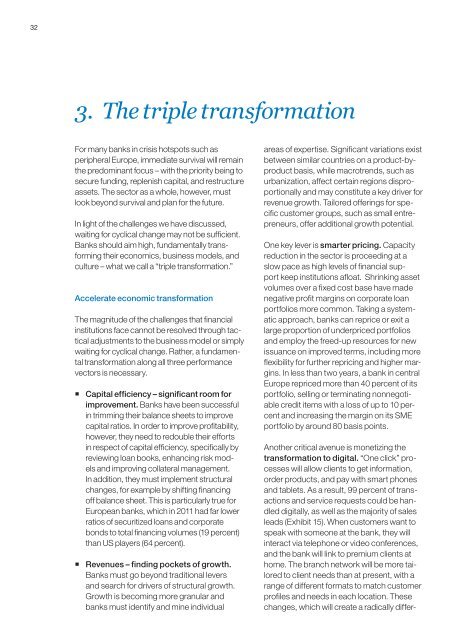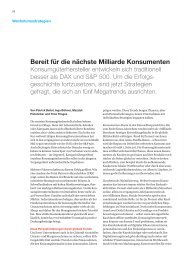The triple transformation - McKinsey & Company
The triple transformation - McKinsey & Company
The triple transformation - McKinsey & Company
Create successful ePaper yourself
Turn your PDF publications into a flip-book with our unique Google optimized e-Paper software.
32<br />
3. <strong>The</strong> <strong>triple</strong> <strong>transformation</strong><br />
For many banks in crisis hotspots such as<br />
pe riph eral Europe, immediate survival will remain<br />
the pre dominant focus – with the priority being to<br />
secure funding, replenish capital, and restructure<br />
assets. <strong>The</strong> sector as a whole, however, must<br />
look beyond survival and plan for the future.<br />
In light of the challenges we have discussed,<br />
waiting for cyclical change may not be sufficient.<br />
Banks should aim high, fundamentally transforming<br />
their economics, business models, and<br />
culture – what we call a “<strong>triple</strong> <strong>transformation</strong>.”<br />
Accelerate economic <strong>transformation</strong><br />
<strong>The</strong> magnitude of the challenges that financial<br />
institutions face cannot be resolved through tactical<br />
adjustments to the business model or simply<br />
waiting for cyclical change. Rather, a fundamental<br />
<strong>transformation</strong> along all three performance<br />
vectors is necessary.<br />
Capital efficiency – significant room for<br />
improvement. Banks have been successful<br />
in trimming their balance sheets to improve<br />
capital ratios. In order to improve profitability,<br />
however, they need to redouble their efforts<br />
in respect of capital efficiency, specifically by<br />
reviewing loan books, enhancing risk models<br />
and improving collateral management.<br />
In addition, they must implement structural<br />
changes, for example by shifting financing<br />
off balance sheet. This is particularly true for<br />
European banks, which in 2011 had far lower<br />
ratios of securitized loans and corporate<br />
bonds to total financing volumes (19 percent)<br />
than US players (64 percent).<br />
Revenues – finding pockets of growth.<br />
Banks must go beyond traditional levers<br />
and search for drivers of structural growth.<br />
Growth is becoming more granular and<br />
banks must identify and mine individual<br />
areas of expertise. Significant variations exist<br />
between similar countries on a productbyproduct<br />
basis, while macrotrends, such as<br />
urbani zation, affect certain regions disproportionally<br />
and may constitute a key driver for<br />
revenue growth. Tailored offerings for specific<br />
cus tomer groups, such as small entrepreneurs,<br />
offer additional growth potential.<br />
One key lever is smarter pricing. Capacity<br />
reduction in the sector is proceeding at a<br />
slow pace as high levels of financial support<br />
keep institutions afloat. Shrinking asset<br />
volumes over a fixed cost base have made<br />
negative profit margins on corpo rate loan<br />
portfolios more common. Taking a systematic<br />
approach, banks can reprice or exit a<br />
large proportion of underpriced portfolios<br />
and employ the freedup resources for new<br />
issuance on improved terms, including more<br />
flexibility for further repricing and higher margins.<br />
In less than two years, a bank in central<br />
Europe repriced more than 40 percent of its<br />
portfolio, selling or terminating nonnegotiable<br />
credit items with a loss of up to 10 percent<br />
and increasing the margin on its SME<br />
portfolio by around 80 basis points.<br />
Another critical avenue is monetizing the<br />
trans formation to digital. “One click” processes<br />
will allow clients to get information,<br />
order pro ducts, and pay with smart phones<br />
and tablets. As a result, 99 percent of transactions<br />
and service requests could be handled<br />
digitally, as well as the majority of sales<br />
leads (Exhibit 15). When customers want to<br />
speak with someone at the bank, they will<br />
interact via telephone or video conferences,<br />
and the bank will link to premium clients at<br />
home. <strong>The</strong> branch network will be more tailored<br />
to client needs than at pre sent, with a<br />
range of different formats to match customer<br />
profiles and needs in each location. <strong>The</strong>se<br />
changes, which will create a radically differ

















